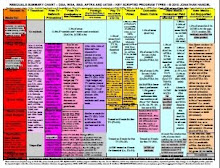Thursday’s SAG election was a victory for the moderate coalition. Yet, strangely enough, the leaders of the losing hardline faction will all find seats on the national board, and will continue to be a shadow government within the union’s Hollywood board—a board on which none of the key moderate leaders will be voting members.
Yes, the moderates (Unite for Strength (UFS) / USAN / RBD / independents) won the national offices – President and Secretary-Treasurer – and picked up additional national board seats and many on the Hollywood board as well. But with SAG, the story is never simple.
In fact, paradoxically, 1st VP and failed Membership First presidential candidate Anne-Marie Johnson will probably continue as 1st VP, ex-president Alan Rosenberg will almost certainly be back on the national board in a matter of days despite winning only an alternate seat, MF leader David Joliffe will probably be on the Hollywood board and effectively on the national board, and MF leader Kent McCord continues on the national and Hollywood boards.
Meanwhile, none of the key moderate leaders will be on the Hollywood board— Unite for Strength leaders Ned Vaughn, Assaf Cohen, Ken Howard and Amy Aquino are all off of that board, at least as voting members (the latter two will serve ex-officio, as non-voting members). Tough independent and former presidential candidate Morgan Fairchild remains, but she’s not a member of the UFS slate and thus doesn’t occupy a leadership position in that group. UFS-ers Adam Arkin and Amy Brenneman also remain, and perhaps will emerge to fill the gap.
How could the election yield so much change in the national offices and so little in the Hollywood Division? Here’s the scenario [UPDATED: Para. 3 is new.]:
1. The moderates seemingly have 27 seats on the Hollywood board out of 55 (because 27 = 6 seats pre-election plus 21 additional seats won in the election). That’s a tad less than half (49%). It would seemingly take peeling off one more vote from MF for the moderates to control the Hollywood board.
2. However, look closer. One of those 6 pre-election seats was held by Ken Howard. Under the SAG Constitution and By-Laws, a national officer can’t also be an elected member of the national board or a Divisional board. So, the day he became president, Howard lost his elected seat on the national and Hollywood boards, and, indeed, his name has been replaced on SAG website listings with “(1 TBD).” That leaves the moderates with 26 seats on the Hollywood board out of 54. That’s less than half by an even greater margin (48%). Now it would take 2 more votes, rather than just one, for the moderates to control the Hollywood board.
3. But, when it comes to electing officers (such as 1st VP) or selecting replacements for the Hollywood and national boards, the news is even bleaker for moderates. That’s because the Hollywood Division Rules of Procedure specify that for such purposes, the only Hollywood Division board members who can vote are national board members (or alternates sitting in for them) from the Hollywood Division. There are 32 such people (33 minus the vacant Ken Howard seat). The moderates control only 9 of those seats, whereas MF has 23.
4. So, Membership First controls who the Hollywood board elects, unless 8 MF-ers break ranks. If that doesn’t happen (and it’s not likely), then MF will fill the TBD vacancy. Whom will they select? Almost certainly Alan Rosenberg, whom they would elevate from national board alternate (which is the office he won on Thursday) to full national board member from the Hollywood division.
5. Thus, although Rosenberg’s presidency was so discredited in many members’ eyes that he couldn’t even win a board seat, he’s likely to end up with one anyway. This would take place at the next Hollywood board meeting, which is scheduled for October 5.
6. Elevating Rosenberg leaves his alternate seat vacant. So, MF would then vote to appoint its longtime leader David Joliffe as a national alternate (and Hollywood board member). That effectively appoints him to the national board, because one or more of MF celebrity board members (which include Martin Sheen, Ed Harris, Elliott Gould and Ed Asner) will usually be absent from national board meetings.
7. MF will also presumably vote to appoint newly reelected board member Anne-Marie Johnson as 1st VP (the VP office from Hollywood) and thus as Divisional chair, to the extent that she doesn’t automatically continue in these offices (note that the updated SAG website still lists her as 1st VP and divisional rules say that the 1st VP is also the chair). This is possible because Johnson ran for two seats in this election—president, but also, as a backup, national board member. She won the latter.
8. As a result, MF will have skilled leadership as voting members in the Hollywood board room, namely, all four of its core leaders: Johnson, Rosenberg, Jolliffe and, continuing on the national and Hollywood boards, Kent McCord.
9. In contrast, Unite for Strength will have none of its leaders as voting members in the Hollywood boardroom: Ned Vaughn and Assaf Cohen didn’t win seats on the Hollywood or national boards, and Ken Howard and Amy Aquino, as national officers, are non-voting, ex officio members of the Hollywood board, as well as the NY and RBD (Regional Branch Division) boards. One wonders whether Howard and/or Aquino will be able to find time to attend every Hollywood board meeting. In any case, their formal roles would be very circumscribed; under the Constitution and By-Laws, they’re not even allowed to make motions or “initiate any other parliamentary procedures.”
10. Note also that the Hollywood board gets to appoint the Hollywood members of the TV/theatrical contract negotiating committee, if there is one, and that Hollywood has a majority on that committee. That suggests that negotiation will once again have to be handled by a task force appointed by the whole board, not by a committee appointed on a Division by Division basis. (It’s unclear to me whether the task force appointed earlier this year is still in existence.) Unless, that is, SAG and AFTRA are able to reestablish joint bargaining under the Phase 1 agreement.
11. Remember too that it was the Hollywood board that passed a resolution expressing the goal that SAG “acquire actors of AFTRA,” i.e. in some mystical fashion divesting AFTRA of its actors and absorbing all of them in SAG. Anne-Marie Johnson ran for and won a seat on the AFTRA board—despite saying it was distasteful to run—giving her an internal platform for this goal as well. We can expect MF to seek to terminate the anti-disparagement agreement so that the Hollywood board will be free to express its anti-AFTRA views without financial repercussion to SAG.
Bottom line: SAG’s byzantine governance structure and geographical divisiveness will once again facilitate disunity. Among other things, the question becomes, will SAG and AFTRA be able to reestablish Phase 1 joint bargaining? The divided governance certainly makes it harder.
———————
Subscribe to my blog (jhandel.com) for more about entertainment law and digital media law. Go to the blog itself to subscribe via RSS or email. Or, follow me on Twitter, friend me on Facebook, or subscribe to my Huffington Post articles. If you work in tech, check out my book How to Write LOIs and Term Sheets.

